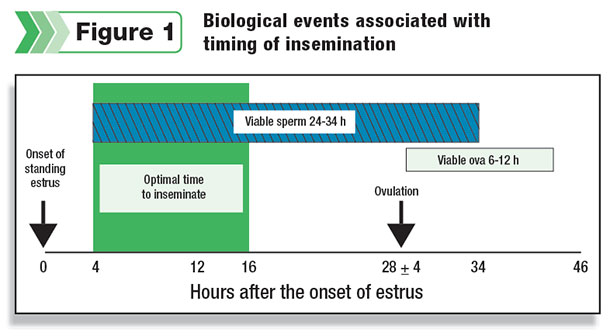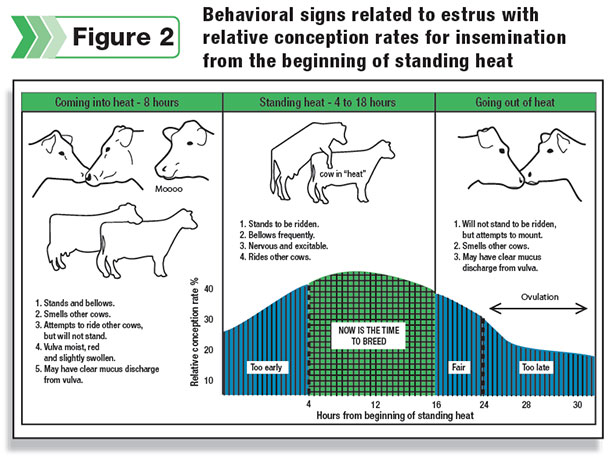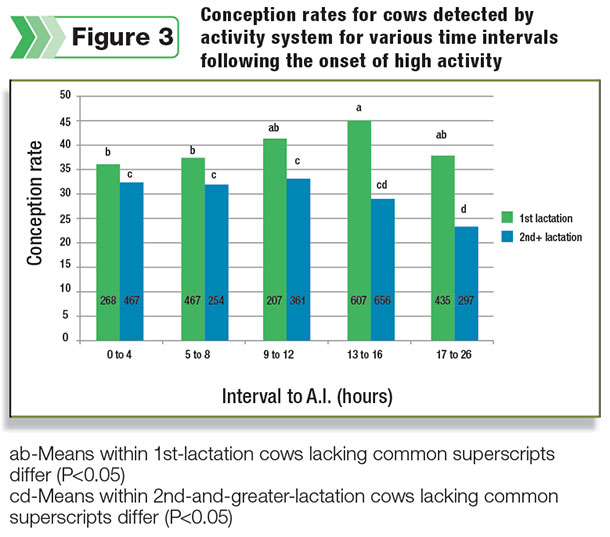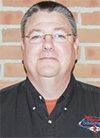Heat detection is often cited as the most costly component and, undoubtedly, the major limiting factor to the success of A.I. programs on many dairy farms. Incorrect detection of estrus is related to loss of income due to extended calving intervals, milk loss, increased veterinary cost, increased heifer-rearing cost and slowed genetic progress. To achieve excellent heat detection, many factors have to be taken into account.
First, the cow must express behavior and physiological changes, and second, these changes must be detected to determine if and when insemination should occur. It is clear an excellent rate of heat detection is vitally important.
The time of ovulation and age of the egg at sperm penetration is critical for conception, so the goal of a heat detection program should not merely be to attain a high detection rate but to achieve a high detection rate with a corresponding high conception rate.
Timed A.I. protocols, chalk and walk, visual observations and electronic activity systems are all methods that allow for A.I., but timing of insemination should be based on the method used and is not similar across the various systems.
Behavioral changes
The occurrence of estrus is due to specific influences of ovarian steroid hormones on behavioral centers in the brain. As a growing follicle matures under the stimulation of follicle stimulating and luteinizing hormones (FSH and LH) during the last three to four days of the estrous cycle, it synthesizes and secretes increasing quantities of estradiol.
A threshold level of estradiol is reached, which triggers two closely linked events – the behavioral response known as estrus and a surge of pituitary hormones, primarily LH. It is useful to point out that the maturity of the Graafian follicle that regulates the amount of estradiol synthesized regulates its own time of ovulation and concurrent maturation of the oocyte.
Traditionally, the cow that stands still and allows others to mount her is in “standing heat.” Standing is the primary sign of estrus. Ovulation usually occurs approximately 24 to 32 hours after the onset of standing estrus in normal dairy cows.
This is important to remember: Biological variation exists, and all cows do not ovulate exactly at the same time because of the level of circulating hormones, size of the developing follicles and many other biological events that must occur, resulting in release of the egg.
After ovulation, there is only a short period when ova can be fertilized ( Figure 1 ). Optimal fertility of ova is projected to be between six and 12 hours after ovulation. The viable life span of sperm in the reproductive tract is estimated at 24 to 34 hours. Timing of A.I. should be based on the prediction of the onset of standing heat ( Figure 2 ).


Timed A.I. protocols have eliminated or minimized the expression of signs associated with heat, but the final GnRH administration used in most timed A.I. protocols acts similar to the natural events, causing a surge of the pituitary hormone LH and resulting in ovulation within approximately 24 hours.
The average period of “standing heat” is usually less than 10 hours and consists of about one standing event per hour. Secondary signs of heat may be an indication that the cow may soon display standing estrus, is currently in estrus or has already gone out of standing heat (Figure 2).
Since the degree of these advanced signs varies in length and intensity, a combination or exhibiting multiple secondary signs increases the reliability of the decision to breed. It can also help to increase the number of cows submitted to A.I. by allowing the insemination of cows that cannot be detected otherwise.
The reason why secondary signs of estrus get this name is they can also be caused by events other than estrus and are secondary to standing to be mounted as the definitive sign. If a cow is not seen standing to be mounted and is suspected in estrus, a combination of secondary signs should be used to confirm the cow is really in estrus.
Visual heat detection
Timing of A.I. solely with visual observations depends on the frequency of observation. Once-a-day observation requires insemination at the next most convenient moment.
A twice-daily observation requires you to determine if the cow is at the beginning of heat or has been in heat for some length of time. Behavioral signs outlined in Figure 2 should be used as a guideline, but the ability to determine the stage of estrus really comes with experience and is more of an art than a science.
If the cow is just starting in standing heat, A.I. at four to 16 hours will be the period that should yield the best opportunity for conception. If the cow has been in heat for a period of time, A.I. at the next convenient moment should be practiced.
When visual observations occur at least three times daily, the recommendation is the a.m./p.m. guideline, whereby cows seen in heat in the morning (a.m.) are inseminated in the evening (p.m.), and cows first observed in the evening (p.m.) are inseminated the next morning (a.m.).
For best results, observations should occur at least once in the early to mid-morning, early afternoon and later in the evening. Observations prior to milking are a good, practical time when cows are intermingling and sexually active groups are easily detected.
Chalk and walk
Usually, the breeder walks cows once daily to determine if the chalk or paint has been removed. This observation, combined with knowing days since last heat or breeding and a quick scrutiny for secondary signs such as rubbed marks, mucous discharge and a swollen, pinkish, moist vulva, make this system a very effective heat detection system. Because cows are only observed once daily, cows should be inseminated soon after detection.
Timed A.I.
The first and most popular timed A.I. protocol is Ovsynch. The last hormone administered in the Ovsynch protocol is GnRH, which causes an LH surge and, subsequently, ovulation within approximately 24 hours.
Because of the biological events shown in Figure 1, insemination is approximately 12 to 18 hours following injection of GnRH to allow the best opportunity for conception. Today, there are countless timed-A.I. protocols, but the last injection will always be GnRH so that the timing of A.I. can follow approximately 12 to 18 hours later.
Activity systems
Not all activity systems are the same, nor do they detect high activity associated with estrus using the same methods or obtain similar accuracy or efficiency of detection. However, the important point for timing of insemination is whether or not your supplier can give a recommended time of A.I. based on research using their specific system to determine the best time of insemination.
The effects of interval to A.I. on conception rates (4,126 breedings) with the Select Detect activity system were consistent with similar studies based on observed mounting activity. Among first-lactation cows ( Figure 3 ), optimum conception occurred at A.I. intervals of eight to 16 hours after the onset of high activity and trended lower for both earlier and later A.I. intervals.

Among second-lactation and older cows, conception rates were similar until 16 hours after the onset of high activity. Optimum conception rates were obtained at intervals near 12 hours after detected estrus, with shorter intervals appearing to be less compromising to conception rates than longer intervals.
Sexed semen vs. conventional semen
A small study using timed A.I. and 100 heifers per treatment group was published in 2011. The most appropriate time for insemination with sex-sorted semen was six hours later than is usually recommended for conventional semen.
Sex-sorted semen has a much lower sperm concentration, and the sperm have been compromised in the process of separation of the X-bearing and Y-bearing sperm, so insemination closer to the time of ovulation makes sense.
Summary
Standing still and allowing other cows to mount is the primary sign of heat, and onset of heat determines the timing of A.I. since ovulation occurs 24 to 32 hours after the onset of standing activity. Making the decision to inseminate will often require the use of secondary signs of estrus.
There is a fine line that will only come with experience when using secondary signs to make the decision to breed or not to breed.
Because of biological variation in the time of ovulation in respect to the onset of estrus, sperm transport time in the female reproductive tract to the site of fertilization, and life span of both gametes (sperm and ova), there is a broad window for the optimum time of A.I., of approximately 12 hours. The key component to timing of A.I. is the method used to detect heat and if the onset of estrus can be determined. PD
Ray Nebel is the V.P. of technical programs for Select Sires. Contact him by email .
References omitted due to space but are available upon request. Click here to email an editor.

Ray Nebel
V.P. of Technical Programs
Select Sires






